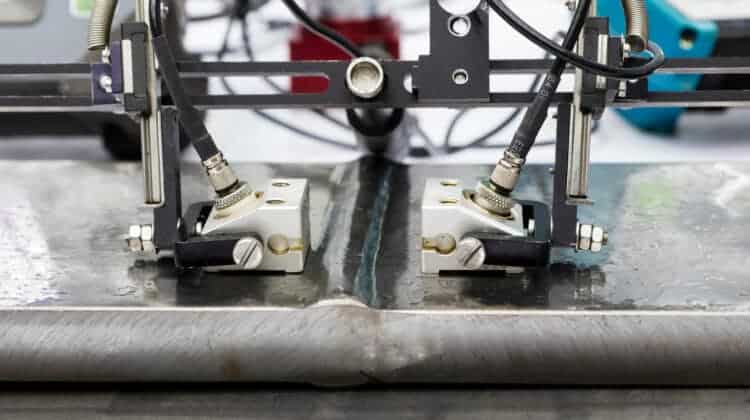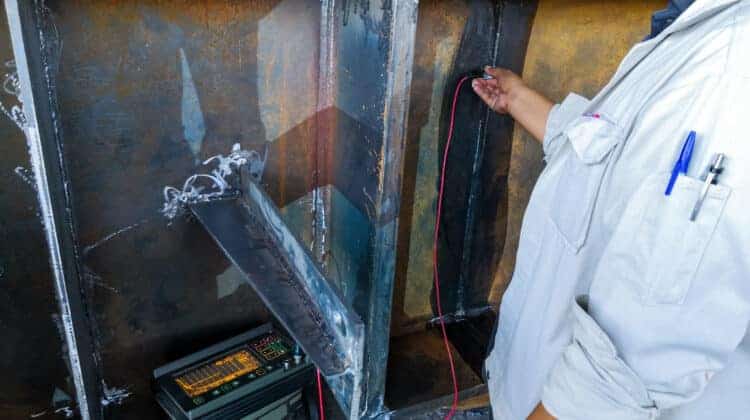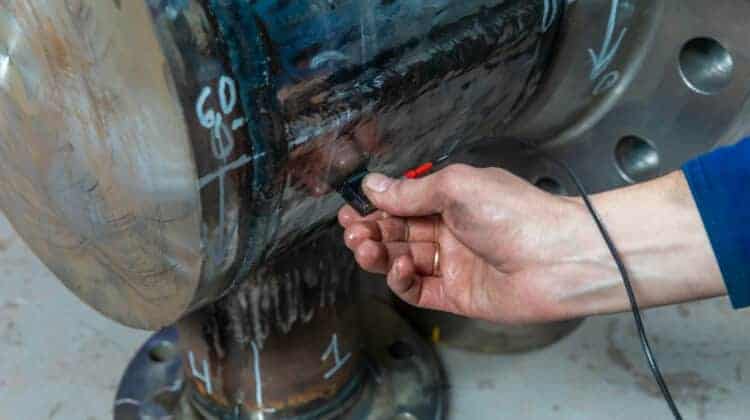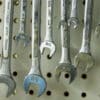Sound waves play a crucial role in how ultrasonic welding works. Ultrasonic welding utilizes ultrasonic vibrations at a high frequency of about 20kHz to 40kHz. This generates heat energy that is used to melt the pieces and weld plastic materials together.
Once cooled, the melted pieces form a strong and solid weld.
Table of Contents
What is ultrasonic welding?
Ultrasonic welding (USW) is a common welding technique that makes use of high-frequency ultrasonic vibrations, which are above audible range, to weld two pieces together. In the process of ultrasonic welding, high-frequency electrical energy is converted into high mechanical motion, and the vibrations produce a solid-state weld to the parts being held together by pressure.
As voltage comes in during the process of ultrasonic welding, the power supply converts the voltage to a new frequency. The electrical energy is then sent to the converter which at this point converts it to mechanical energy.
This welding technique is much faster, easy to automate, cost-effective, and suitable for thermoplastic material mass welding as well welding of dissimilar materials. In addition, metals with a thin section can be welded using ultrasonic welding.
The frequency range used in this process is between 20kHz to 40kHz to join two pieces together. The parts of the plastic to be welded are positioned between the sonotrode and the anvil. In most cases, these parts are made of titanium or aluminum.
While the welding takes place, the sonotrode is connected to a transducer which generates and releases acoustic vibrations. These vibrations move from the transducer to the parts being welded through the sonotrode utilizing a high-frequency speed between 16 kHz and 75 kHz.
The major parts of ultrasonic welding
Now that we know what ultrasonic welding is all out and how it is carried out, here are some of the most important parts of the ultrasonic welding process.
- The machine press — The press is used to clutch the welding system and also used to apply pressure on the two plastic workpieces to be welded. It is made up of a base plate which is used to keep the cooling jig in place.There is a pressure gauge used to determine the pressure during the welding process and a regulator for balancing the welding force. The machine press can either be a pneumatic driven type or an electric driven type.
- The ultrasonic generator — The generator converts electrical energy to the needed voltage and frequency from a single-phase main source. The microprocessor unit in the generator controls the welding cycle and the welder is able to access welding communication via the user interface. This interface is essential as it aids the welder in inputting the required welding specifications.
- Ultrasonic welding stack — This part of the welding machine is in charge of providing ultrasonic vibrations.The ultrasonic welding stack is made up of three parts: the welding horn or sonotrode, the piezoelectric transducer or converter, and the booster, all of which are set up on the machine press at the mid-point of the booster. These three parts are tuned to function on a resonate frequency which must match the generator’s electrical frequency for optimal results. The resonate frequencies include 15 kHz, 20 kHz, 30 kHz, 35 kHz, or 40 kHz.
- Anvil — The anvil is an attaching device that is used to hold and fasten two plastic pieces together. It enables the high-frequency vibration directed to the interface of the two pieces to be welded.
Difference between vibration and ultrasonic welding
More often than not, people mix up vibration welding and ultrasonic welding or refer to them as the same type of process. Although they both make use of vibration energy to join plastic pieces, their processes are quite distinct from each other.
Vibration welding and ultrasonic welding both produce friction and generate heat to join plastics materials using vibration. The vibration welding process generates heat needed for welding by vibrating one section relative to another in a straight side-by-side motion.
On the other hand, ultrasonic welding occurs by vibrating one component perpendicularly to another component at an extremely fast pace such that molecular friction is produced and heat is also generated.
When it comes to frequency of vibration, the vibration welding process takes place roughly 120-240 times per second (Hz). This range depends on the size of the part to be welded. In addition, the frequency is within the human hearing range which is why equipment used in vibration welding also uses sound-dampening tools to protect the welder from deafening sounds.
Ultrasonic welding on the flip side vibrates at ultrasonic frequencies. These frequencies are way above what humans can hear, mostly 20,000 Hz to 20 kHz. A lot of ultrasonic welding processes take place between 20 Hz to 40 Hz, they produce high-pitched screeching noise as a result of lower resonant frequencies from the plastic pieces.
Vibration welding is a fast welding process compared to other joining processes. They are able to weld large assemblies such as infrared welding. Vibration welding produces strong leak-proof welds and is suitable for welding power tools, home appliances, armrests, instrument panels, and more.
For welding smaller components, ultrasonic welding is a more suited choice. They are also fast, produce leak-proof welds, they and are also suitable for welding instrument cluster trim, small electronic housings, packaging, and others.
Applications of ultrasonic welding
There are numerous applications of ultrasonic welding in various industries as a result of the quality of welds it produces without applying direct heat. That said, here are some of its applications.
- Computer and Electrical Industries — Ultrasonic welding is used in this industry to join wired connections and to generate small delicate circuits. It is used in assembling field coils, transformers, electric motors, and more. In the computer industry, ultrasonic welding is used to assemble flash drives and computer disks to the required high volumes.
- Medical industry — In the medical industry, ultrasonic welding is used in the production of certain machines used to clean rooms. This is because it helps prevent degradation of the welds and the biocompatibility of the welding parts.Generally, this reduces the production cost without affecting the quality of the materials. It is also used in the production of medical products like face masks, gas filters, anesthesia filters, blood filters, intravenous spikes, and more.
- Aerospace and automotive industries — Ultrasonic welding is used in the automobile field to weld large plastic as well as electrical components such as steering wheels, door panels, air ducts, and engine parts. It is a choice method because it is low cost, flexible, uses reduced cycle times and automation. It also does not damage the surface furnish of the components.In aerospace, ultrasonic welding is used to weld lighter aircraft parts (mostly aluminum), and also weld gauge metals.
- Packaging industry — Here, it is used in sealing packs, containers, and more. It is also used in packaging harmful materials that need hermetic sealing and cannot be sealed at high temperatures, including explosives, fireworks, and the like. Ultrasonic welding is also used in sealing food material and for food packaging.
How do you break an ultrasonic weld?
Truth be told, it might not be so easy to break an ultrasonic weld because they are strong. However, it is possible to break it by squeezing the weld from opposite corners such that some enclosures will crack along the welded lines. It might be challenging to do this without mangling the material.
Another way is by using high-impact shock or whacking it with a screwdriver or hammer.
What are the effects of ultrasonic welding on health?
Compared to other welding techniques, ultrasonic welding is quite safe. Although there have been several debates about the safety of the welding method, ultrasonic welding has been in use for over 40 years and has been proven safe.
However, there maybe be cases of excess noise as a result of the ultrasonic vibrations. And in rare cases, pacemakers may be affected by electromagnetic energy.
In ultrasonic welding, accuracy, and precision are some of the most important factors, this is why the machines, equipment, and processes can only be handled by well-trained and skilled personnel. Routine maintenance should also be conducted to increase the lifespan of the ultrasonic machines.





